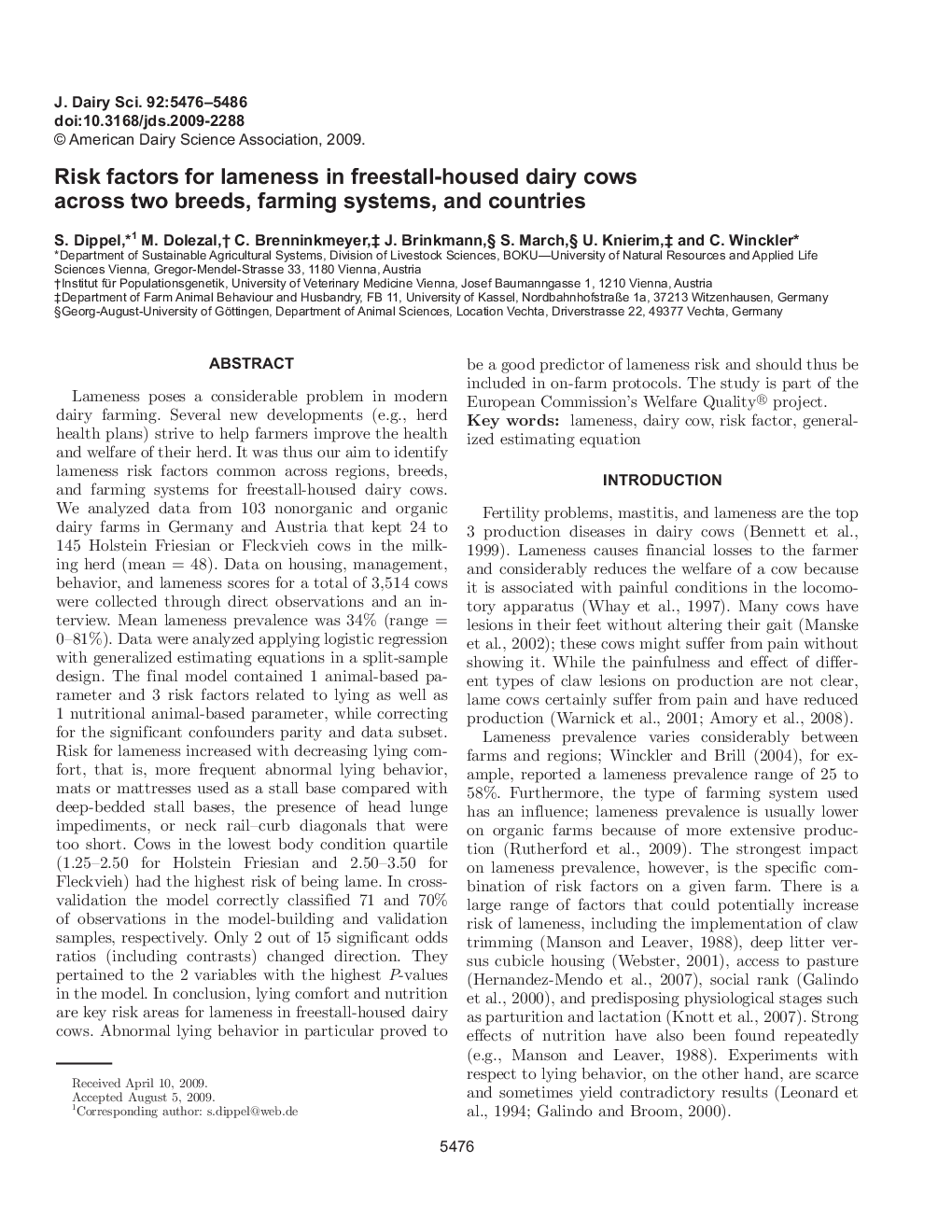| کد مقاله | کد نشریه | سال انتشار | مقاله انگلیسی | نسخه تمام متن |
|---|---|---|---|---|
| 2439113 | 1108087 | 2009 | 11 صفحه PDF | دانلود رایگان |
عنوان انگلیسی مقاله ISI
Risk factors for lameness in freestall-housed dairy cows across two breeds, farming systems, and countries
دانلود مقاله + سفارش ترجمه
دانلود مقاله ISI انگلیسی
رایگان برای ایرانیان
کلمات کلیدی
موضوعات مرتبط
علوم زیستی و بیوفناوری
علوم کشاورزی و بیولوژیک
علوم دامی و جانورشناسی
پیش نمایش صفحه اول مقاله

چکیده انگلیسی
Lameness poses a considerable problem in modern dairy farming. Several new developments (e.g., herd health plans) strive to help farmers improve the health and welfare of their herd. It was thus our aim to identify lameness risk factors common across regions, breeds, and farming systems for freestall-housed dairy cows. We analyzed data from 103 nonorganic and organic dairy farms in Germany and Austria that kept 24 to 145 Holstein Friesian or Fleckvieh cows in the milking herd (mean = 48). Data on housing, management, behavior, and lameness scores for a total of 3,514 cows were collected through direct observations and an interview. Mean lameness prevalence was 34% (range = 0-81%). Data were analyzed applying logistic regression with generalized estimating equations in a split-sample design. The final model contained 1 animal-based parameter and 3 risk factors related to lying as well as 1 nutritional animal-based parameter, while correcting for the significant confounders parity and data subset. Risk for lameness increased with decreasing lying comfort, that is, more frequent abnormal lying behavior, mats or mattresses used as a stall base compared with deep-bedded stall bases, the presence of head lunge impediments, or neck rail-curb diagonals that were too short. Cows in the lowest body condition quartile (1.25-2.50 for Holstein Friesian and 2.50-3.50 for Fleckvieh) had the highest risk of being lame. In cross-validation the model correctly classified 71 and 70% of observations in the model-building and validation samples, respectively. Only 2 out of 15 significant odds ratios (including contrasts) changed direction. They pertained to the 2 variables with the highest P-values in the model. In conclusion, lying comfort and nutrition are key risk areas for lameness in freestall-housed dairy cows. Abnormal lying behavior in particular proved to be a good predictor of lameness risk and should thus be included in on-farm protocols. The study is part of the European Commission's Welfare Quality® project.
ناشر
Database: Elsevier - ScienceDirect (ساینس دایرکت)
Journal: Journal of Dairy Science - Volume 92, Issue 11, November 2009, Pages 5476-5486
Journal: Journal of Dairy Science - Volume 92, Issue 11, November 2009, Pages 5476-5486
نویسندگان
S. Dippel, M. Dolezal, C. Brenninkmeyer, J. Brinkmann, S. March, U. Knierim, C. Winckler,